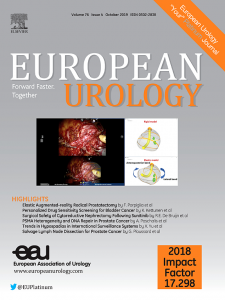Erdafitinib in Patients with High- and Intermediate-risk Non–muscle-invasive Bladder Cancer: Final Analysis of THOR-2 Study
IF 25.2
1区 医学
Q1 UROLOGY & NEPHROLOGY
引用次数: 0
Abstract
Background and objective
High-risk (HR) or intermediate-risk (IR) non–muscle-invasive bladder cancer (NMIBC) carries a high probability of recurrence and/or progression. We present the final analysis results of erdafitinib in HR- or IR-NMIBC with fibroblast growth factor receptor 3/2 alterations (FGFR3/2alt) from the phase 2 THOR-2 study.Methods
Cohort 1 (HR-NMIBC papillary only) with prior bacillus Calmette-Guérin was randomized 2:1 to erdafitinib or intravesical chemotherapy. Cohorts 2 (carcinoma in situ ± papillary) and 3 (IR-NMIBC) received erdafitinib. The primary endpoint was recurrence-free survival (RFS) for cohort 1. Exploratory endpoints included complete response (CR) rate and duration of response (DoR) for cohorts 2 and 3.Key findings and limitations
In cohort 1 (n = 73), median RFS was not reached (NR) for erdafitinib (95% confidence interval [CI] 28.6 mo–not estimable [NE]) and 11.6 mo (95% CI 5.3–NE) for intravesical chemotherapy (hazard ratio 0.28 [95% CI 0.13–0.61; nominal p = 0.0007]; median follow-up, 18.5 and 16.6 mo, respectively). In cohort 2 (n = 16), CR rates were 94% (95% CI 70–100%) and 81% (95% CI 54–96%) at 8 and 32 wk, respectively; the median DoR (mDoR) was 23.3 mo (95% CI 10.0–NE; n = 15). In cohort 3 (n = 18), the CR rate was 89% (95% CI 65–99%) and mDoR was NR (95% CI 13.4 mo–NE). Most common treatment-related adverse event in pooled erdafitinib cohorts (N = 83) was hyperphosphatemia (76%). Limitations include early termination in cohort 1 and small sample size that precluded prespecified hypothesis testing.Conclusions and clinical implications
Oral erdafitinib demonstrated high efficacy in FGFR3/2alt HR-/IR-NMIBC, with a manageable safety profile.Erdafitinib在高、中危非肌浸润性膀胱癌患者中的应用:THOR-2研究的最终分析
背景和目的高风险(HR)或中危(IR)非肌浸润性膀胱癌(NMIBC)具有很高的复发和/或进展概率。我们给出了erdafitinib在HR-或IR-NMIBC中与成纤维细胞生长因子受体3/2改变(FGFR3/2alt)的2期研究的最终分析结果。方法将先前感染卡尔梅特-谷氨酰胺芽孢杆菌的scohort 1 (HR-NMIBC乳头状)随机分为2组:厄达非替尼组或膀胱化疗组。2组(原位癌±乳头状癌)和3组(IR-NMIBC)接受厄达非替尼治疗。主要终点是队列1的无复发生存期(RFS)。探索性终点包括队列2和3的完全缓解率(CR)和反应持续时间(DoR)。在队列1 (n = 73)中,厄达非替尼的中位RFS未达到(NR)(95%可信区间[CI] 28.6 mo -不可估计[NE]),膀胱内化疗的中位RFS为11.6 mo (95% CI 5.3-NE)(风险比0.28 [95% CI 0.13-0.61; nominal p = 0.0007];中位随访时间分别为18.5和16.6 mo)。在队列2 (n = 16)中,8周和32周时的CR率分别为94% (95% CI 70-100%)和81% (95% CI 54-96%);中位DoR (mDoR)为23.3个月(95% CI 10.0-NE; n = 15)。在队列3 (n = 18)中,CR率为89% (95% CI 65-99%), mDoR为NR (95% CI 13.4 mo-NE)。厄达非替尼合并队列(N = 83)中最常见的治疗相关不良事件是高磷血症(76%)。局限性包括队列1的早期终止和小样本量排除了预先指定的假设检验。结论和临床意义厄达非替尼口服治疗FGFR3/2alt HR-/IR-NMIBC疗效高,安全性可控。
本文章由计算机程序翻译,如有差异,请以英文原文为准。
求助全文
约1分钟内获得全文
求助全文
来源期刊

European urology
医学-泌尿学与肾脏学
CiteScore
43.00
自引率
2.60%
发文量
1753
审稿时长
23 days
期刊介绍:
European Urology is a peer-reviewed journal that publishes original articles and reviews on a broad spectrum of urological issues. Covering topics such as oncology, impotence, infertility, pediatrics, lithiasis and endourology, the journal also highlights recent advances in techniques, instrumentation, surgery, and pediatric urology. This comprehensive approach provides readers with an in-depth guide to international developments in urology.
 求助内容:
求助内容: 应助结果提醒方式:
应助结果提醒方式:


